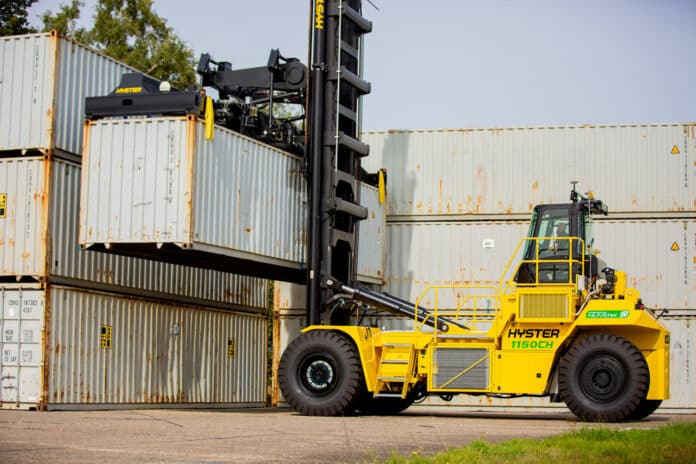An Oregon-based lift truck designer and manufacturer, Hyster Company, has announced testing a top-pick container handler powered by hydrogen fuel cells (HFC) at Fenix Marine Services in the Port of Los Angeles.
Built on the industry standard Hyster H1050-1150XD-CH top-pick container handler design, the truck is powered by two 45kw hydrogen fuel cells from Nuvera, a wholly owned subsidiary of Hyster’s parent company Hyster-Yale Group.
The newly-designed HFC-powered top pick is designed to provide the zero-emissions benefits of a battery-electric option, with enough capacity to keep operators moving and avoid the need to stop in the middle of a shift to refuel or recharge. Refueling the top pick with hydrogen fuel is expected to take approximately 15 minutes, with the intention to provide eight to 10 hours of continuous run time, all while producing no harmful emissions – only water and heat.
The hydrogen fuel cell works in tandem with an onboard lithium-ion battery to either power the equipment directly or charge the onboard battery. The top pick is also equipped with a patented Hyster energy recovery system for electric container handlers that recovers and stores energy from lowering loads and braking. The Fenix Marine Services (FMS) container terminal uses compressed hydrogen delivered on-site to fuel the HFC top pick.
To electrify higher-capacity equipment for port terminals, Hyster draws on extensive experience in electric truck design with the company’s line of smaller, lighter-capacity powered industrial trucks used in both indoor and outdoor settings.
“Our mission is to provide the innovative technologies our customers need to help meet their goals for emissions reduction and performance. For some operations, lithium-ion power might be the answer, but for others, hydrogen is the right choice,” says Jan Willem van den Brand, director of global market development, big trucks, Hyster. “The answer depends on so many factors like duty cycle, utility grid capacity, and fuel availability. Our customers deserve choices that allow them to build the right solution based on their needs – not shoehorning a single technology into their operation.”
The project is part of the California Climate Investments, an initiative that focuses on reducing greenhouse gas emissions, strengthening the economy, improving public health and the environment, and providing meaningful benefits to the most disadvantaged communities, low-income communities, and low-income households.
